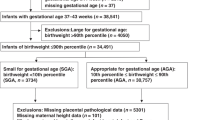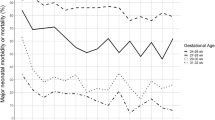Abstract
Objective
Our aim was to investigate the association between large-for-gestational-age and the risk of spontaneous preterm birth.
Study Design
We studied nulliparous women with a singleton gestation using data from the Dutch perinatal registry from 1999 to 2010. Neonates were categorized according to the Hadlock fetal weight standard, into 10th to 90th percentile, 90th to 97th percentile, or above 97th percentile. Outcomes were preterm birth <37+0 weeks and preterm birth between 25+0–27+6 weeks, 28+0–30+6 weeks, 31+0–33+6 weeks, and 34+0–36+6 weeks.
Results
We included 547,418 women. The number of spontaneous preterm births <37 weeks was significantly increased in the large-for-gestational-age group ( > p97) compared with fetuses with a normal growth (p10–p90) (11.3% vs. 7.3%, odds ratio (OR) 1.8; 95% CI 1.7–1.9). The same results were found when limiting analyses to women with certain pregnancy duration (after in vitro fertilization).
Conclusion
Large-for-gestational-age increases the risk of spontaneous preterm delivery from 25 weeks of gestation onwards.
This is a preview of subscription content, access via your institution
Access options
Subscribe to this journal
Receive 12 print issues and online access
$259.00 per year
only $21.58 per issue
Buy this article
- Purchase on Springer Link
- Instant access to full article PDF
Prices may be subject to local taxes which are calculated during checkout


Similar content being viewed by others
References
Beck S, Wojdyla D, Say L, Betran AP, Merialdi M, Requejo JH, et al. The worldwide incidence of preterm birth: a systematic review of maternal mortality and morbidity. Bull World Health Organ. 2010;88:31–38.
WHO: recommended definitions, terminology and format for statistical tables related to the perinatal period and use of a new certificate for cause of perinatal deaths. Modifications recommended by FIGO as amended October 14, 1976. Acta Obstet Et Gynecol Scand. 1977;56:247–53.
Schaaf JM, Mol BW, Abu-Hanna A, Ravelli AC. Trends in preterm birth: singleton and multiple pregnancies in the Netherlands, 2000-2007. BJOG. 2011;118:1196–204.
Nederland SPR 2014 [cited]. Available from: https://assets.perined.nl/docs/353d9249-9875-4cb3-9c86-f078ae3f7aef.pdf
Zeitlin J, Szamotulska K, Drewniak N, Mohangoo AD, Chalmers J, Sakkeus L, et al. Preterm birth time trends in Europe: a study of 19 countries. BJOG. 2013;120:1356–65.
Delnord M, Blondel B, Zeitlin J. What contributes to disparities in the preterm birth rate in European countries? Curr Opin Obstet Gynecol. 2015;27:133–42.
Boyd HA, Poulsen G, Wohlfahrt J, Murray JC, Feenstra B, Melbye M. Maternal contributions to preterm delivery. Am J Epidemiol. 2009;170:1358–64.
Goldenberg RL, Culhane JF, Iams JD, Romero R. Epidemiology and causes of preterm birth. Lancet. 2008;371:75–84.
Brown HK, Speechley KN, Macnab J, Natale R, Campbell MK. Biological determinants of spontaneous late preterm and early term birth: a retrospective cohort study. BJOG. 2015;122:491–9.
Lackman F, Capewell V, Richardson B, daSilva O, Gagnon R. The risks of spontaneous preterm delivery and perinatal mortality in relation to size at birth according to fetal versus neonatal growth standards. Am J Obstet Gynecol. 2001;184:946–53.
Ou CW, Orsino A, Lye SJ. Expression of connexin-43 and connexin-26 in the rat myometrium during pregnancy and labor is differentially regulated by mechanical and hormonal signals. Endocrinology. 1997;138:5398–407.
Tromp M, Meray N, Ravelli AC, Reitsma JB, Bonsel GJ. Medical record linkage of anonymous registries without validated sample linkage of the Dutch perinatal registries. Stud Health Technol Inform. 2005;116:125–30.
Zeitlin J, Ancel PY, Saurel-Cubizolles MJ, Papiernik E. The relationship between intrauterine growth restriction and preterm delivery: an empirical approach using data from a European case-control study. BJOG. 2000;107:750–8.
Ott WJ. Intrauterine growth retardation and preterm delivery. Am J Obstet Gynecol. 1993;168(6 Pt 1):1710–5. Discussion1715–17
Kase BA, Carreno CA, Blackwell SC, Sibai BM. The impact of medically indicated and spontaneous preterm birth among hypertensive women. Am J Perinatol. 2013;30:843–8.
Boulet SL, Alexander GR, Salihu HM, Pass M. Macrosomic births in the united states: determinants, outcomes, and proposed grades of risk. Am J Obstet Gynecol. 2003;188:1372–8.
Ye J, Torloni MR, Ota E, Jayaratne K, Pileggi-Castro C, Ortiz-Panozo E, et al. Searching for the definition of macrosomia through an outcome-based approach in low- and middle-income countries: a secondary analysis of the WHO Global Survey in Africa, Asia and Latin America. BMC Pregnancy Childbirth. 2015;15:324.
Hadlock FP, Harrist RB, Martinez-Poyer J. In utero analysis of fetal growth: a sonographic weight standard. Radiology. 1991;181:129–33.
NVOG. Dutch guideline Fetal growth restriction, version 2.1. [website] 2008 2008-09-17 [cited 9 March 2017]. Available from: http://nvog-documenten.nl/index.php?pagina=/richtlijn/pagina.php&fSelectTG_62=75&fSelectedSub=62&fSelectedParent=75
Hadlock FP, Harrist RB, Sharman RS, Deter RL, Park SK. Estimation of fetal weight with the use of head, body, and femur measurements–a prospective study. Am J Obstet Gynecol. 1985;151:333–7.
Adams Waldorf KM, Singh N, Mohan AR, Young RC, Ngo L, Das A, et al. Uterine overdistention induces preterm labor mediated by inflammation: observations in pregnant women and nonhuman primates. Am J Obstet Gynecol. 2015;213:830.e831–830.e819.
Bacelis J, Juodakis J, Adams Waldorf KM, Sengpiel V, Muglia LJ, Zhang G, et al. Uterine distention as a factor in birth timing: retrospective nationwide cohort study in Sweden. BMJ Open. 2018;8:e022929.
Morken NH, Kallen K, Jacobsson B. Fetal growth and onset of delivery: a nationwide population-based study of preterm infants. Am J Obstet Gynecol. 2006;195:154–61.
Kamphuis EI, Koullali B, Hof M, de Groot CJ, Kazemier BM, Robertson S, et al. Fetal gender of the first born and the recurrent risk of spontaneous preterm birth. Am J Perinatol. 2015;32:1305–10.
Kazemier BM, Buijs PE, Mignini L, Limpens J, de Groot CJ, Mol BW. Impact of obstetric history on the risk of spontaneous preterm birth in singleton and multiple pregnancies: a systematic review. BJOG. 2014;121:1197–208. discussion 1209
Schaaf JM, Hof MH, Mol BW, Abu-Hanna A, Ravelli AC. Recurrence risk of preterm birth in subsequent singleton pregnancy after preterm twin delivery. Am J Obstet Gynecol. 2012;207:279.e271–277.
Vergouw CG, Kostelijk EH, Doejaaren E, Hompes PG, Lambalk CB, Schats R. The influence of the type of embryo culture medium on neonatal birthweight after single embryo transfer in IVF. Hum Reprod. 2012;27:2619–26.
Luke B, Brown MB, Wantman E, Stern JE, Toner JP, Coddington CC 3rd. Increased risk of large-for-gestational age birthweight in singleton siblings conceived with in vitro fertilization in frozen versus fresh cycles. J Assist Reprod Genet. 2017;34:191–200.
Zandstra H, Van Montfoort AP, Dumoulin JC. Does the type of culture medium used influence birthweight of children born after IVF? Hum Reprod. 2015;30:530–42.
Oteng-Ntim E, Varma R, Croker H, Poston L, Doyle P. Lifestyle interventions for overweight and obese pregnant women to improve pregnancy outcome: systematic review and meta-analysis. BMC Med. 2012;10:47.
Koivusalo SB, Rono K, Klemetti MM, Roine RP, Lindstrom J, Erkkola M, et al. Gestational diabetes mellitus can be prevented by lifestyle intervention: the Finnish Gestational Diabetes Prevention Study (RADIEL): a randomized controlled trial. Diabetes Care. 2016;39:24–30.
Bruno R, Petrella E, Bertarini V, Pedrielli G, Neri I, Facchinetti F. Adherence to a lifestyle programme in overweight/obese pregnant women and effect on gestational diabetes mellitus: a randomized controlled trial. Mater Child Nutr. 2017;13. e-pub ahead of print 19 september 2016. https://doi.org/10.1111/mcn.12333.
Wang C, Wei Y, Zhang X, Zhang Y, Xu Q, Sun Y, et al. A randomized clinical trial of exercise during pregnancy to prevent gestational diabetes mellitus and improve pregnancy outcome in overweight and obese pregnant women. Am J Obstet Gynecol. 2017;216:340–351.
Simmons D, Devlieger R, van Assche A, Jans G, Galjaard S, Corcoy R, et al. Effect of physical activity and/or healthy eating on GDM risk: The DALI Lifestyle Study. J Clin Endocrinol Metab. 2017;102:903–13.
Magro-Malosso ER, Saccone G, Di Mascio D, Di Tommaso M, Berghella V. Exercise during pregnancy and risk of preterm birth in overweight and obese women: a systematic review and meta-analysis of randomized controlled trials. Acta Obstet Gynecol Scand. 2017;96:263–73.
Morrens A, Verhaeghe J, Vanhole C, Devlieger R, Mathieu C, Benhalima K. Risk factors for large-for-gestational age infants in pregnant women with type 1 diabetes. BMC Pregnancy Childbirth. 2016;16:162.
Acknowledgements
We thank all Dutch midwives, obstetricians, neonatologists, and other perinatal healthcare providers for the registration of perinatal information and the Foundation of The Netherlands Perinatal Registry (https://www.perined.nl) for permission to use the registry data.
Author information
Authors and Affiliations
Corresponding author
Ethics declarations
Conflict of interest
Prof. dr. B.W. Mol reports consultancy for ObsEva, Merck and Guerbet.
Additional information
Publisher’s note: Springer Nature remains neutral with regard to jurisdictional claims in published maps and institutional affiliations.
Supplementary information
Rights and permissions
About this article
Cite this article
van Zijl, M.D., Oudijk, M.A., Ravelli, A.C.J. et al. Large-for-gestational-age fetuses have an increased risk for spontaneous preterm birth. J Perinatol 39, 1050–1056 (2019). https://doi.org/10.1038/s41372-019-0361-6
Received:
Revised:
Accepted:
Published:
Issue Date:
DOI: https://doi.org/10.1038/s41372-019-0361-6



